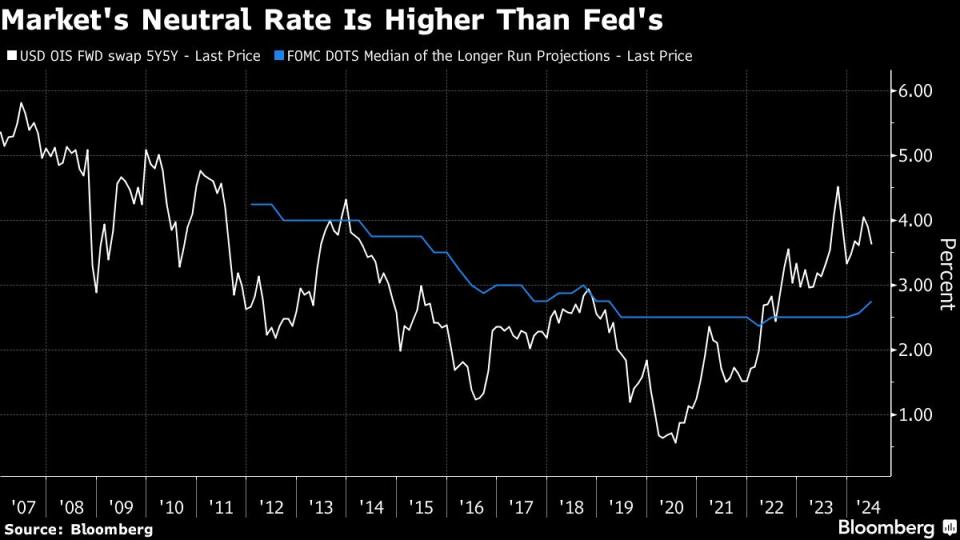(Bloomberg) — Just as investor optimism is growing that a U.S. Treasury rally is underway, a key bond market indicator is sending a worrying signal to anyone thinking about getting in.
Most read from Bloomberg
First the good news. With the midpoint of 2024 in sight, US Treasuries are poised to recoup their losses for the year as signs finally appear that inflation and the labor market are actually cooling. Traders are now betting that this could be enough for the Federal Reserve to start cutting rates as early as September.
But what may limit the central bank’s ability to cut spending, creating headwinds for bonds, is the growing view in markets that the economy’s so-called neutral interest rate – a theoretical level of borrowing costs that neither boosts nor slows growth – is much higher than that of policymakers. currently projecting.
“The significance is that when the economy inevitably slows, there will be fewer rate cuts over the next decade and interest rates could be higher than they have been over the past decade,” said Troy Ludtka, senior U.S. economist at SMBC Nikko. Securities America, Inc.

Forward contracts that point to five-year yields over the next five years – a measure of the market’s view of where U.S. yields might end up – have stalled at 3.6%. While that’s down from last year’s peak of 4.5%, it’s still more than a full percentage point higher than the average over the past decade and above the Fed’s own estimate of 2.75%.
This is important because it means the market is pricing in a much higher floor for returns. The practical implication is that there are potential limits to the scope of bonds. This should be a concern for investors preparing for the kind of epic bond rally that saved them late last year.
For the time being, the mood among investors is becoming increasingly optimistic. A Bloomberg measure of Treasury yields fell just 0.3% in 2024 after losing as much as 3.4% at the year’s low. Benchmark yields are down about half a percentage point from their April-to-date peak.
Traders have been busy in recent sessions with contrarian bets that could take advantage of increased odds that the Fed will cut rates as early as July, and that demand for futures contracts is seeing a huge rebound in the bond market.
But if the market is right and says that the neutral rate – which cannot be observed in real time because it is subject to too many forces – has risen permanently, then the Fed’s current rate of over 5% may not be that restrictive as is thought. A Bloomberg gauge shows that financial conditions are relatively simple.
“We have only seen a fairly gradual slowdown in economic growth, and that would indicate that neutral rates are significantly higher,” said Bob Elliott, CEO and Chief Investment Officer at Unlimited Funds Inc. in long-term bonds, “cash looks more attractive than bonds,” he added.
The actual level of the neutral rate, or R-Star as it is also known, has become the subject of intense debate. Reasons for a possible upward shift, which would reverse a decades-long downward trend, include expectations for large and prolonged government budget deficits and increased investments in the fight against climate change.
Further gains in bonds may require a more pronounced slowdown in inflation and growth to cut rates faster and more deeply than the Fed currently envisions. A higher neutral interest rate would make this scenario less likely.
Economists expect data next week to show that the Fed’s preferred gauge of underlying inflation fell to an annualized rate of 2.6% last month from 2.8%. While that is the lowest figure since March 2021, it remains above the Fed’s target of 2% inflation. And the unemployment rate has been at or below 4% for more than two years, the best performance since the 1960s.
“While we see both households and businesses suffering from higher interest rates, overall as a system we have clearly handled it very well,” said Phoebe White, head of U.S. inflation strategy at JPMorgan Chase & Co.
The performance of financial markets also suggests that the Fed’s policy may not be restrictive enough. The S&P 500 has been breaking records almost daily, even as shorter-term inflation-adjusted interest rates, cited by Fed Chairman Jerome Powell as an input for measuring the impact of Fed policy, have risen nearly 6 percentage points since 2022.
“You have a market that has been incredibly resilient in the face of higher real yields,” said Jerome Schneider, head of short-term portfolio management and financing at Pacific Investment Management Co.
What Bloomberg Strategists Say…
“In just a few dashes, the Federal Reserve has raised its estimate of the nominal neutral rate from 2.50% to 2.80% – showing how central banks around the world are still trying to weaponize the scale of interest rates to skip. the economic expansion and inflation that we see in this cycle. Therefore, current market pricing, which expects almost two full rate cuts from the Fed this year, appears exaggerated.”
— Ven Ram, cross-asset strategist
With the exception of a few Fed officials like Governor Christopher Waller, most policymakers are moving toward the camp of higher neutral interest rates. But their estimates varied within a wide range from 2.4% to 3.75%, underscoring the uncertainties in making the predictions.
Powell, speaking to reporters on June 12 after the two-day central bank policy meeting, appeared to downplay its importance in Fed decision-making, saying that “we can’t really know” whether or not the neutral rate will be has not increased. .
It is not unknown to some in the market. It is a new, higher reality. And it’s a potential roadblock to a rally.
What to watch
-
Economic data:
-
June 24: Production activity by the Dallas Fed
-
June 25: Philadelphia Fed non-production; Chicago Fed National Activity; FHFA home price index; S&P CoreLogic; The Conference Board’s Consumer Confidence Report; Richmond Fed Manufacturing Index and Business Conditions; Dallas Fed Services Activity;
-
June 26: MBA Mortgage Applications; sales of new houses
-
June 27: Progress on the merchandise trade balance; GDP 1st quarter (third reading); wholesale/retail supplies; initial unemployment claims; durable goods; current home sales; Production by the Kansas City Fed
-
June 28: Personal income and expenses; PCE deflator; MNI Chicago PMI; Sentiment from the University of Michigan (last lecture); Kansas City Fed Service
-
-
Fed Calendar:
-
June 24: Fed Governor Christopher Waller; Mary Daly, chair of the San Francisco Fed
-
June 25: Fed Governor Michelle Bowman; Fed Governor Lisa Cook
-
June 28: Thomas Barkin, president of the Richmond Fed; Bowman
-
-
Auction calendar:
-
June 24: 13 and 26 week bills
-
June 25: 42 days CMB; 2-year notes;
-
June 26: 2-year FRN reopening; 17 week bills; 5-year notes
-
June 27: 4 and 8 week bills; 7-year notes
-
Most read from Bloomberg Businessweek
©2024 BloombergLP







